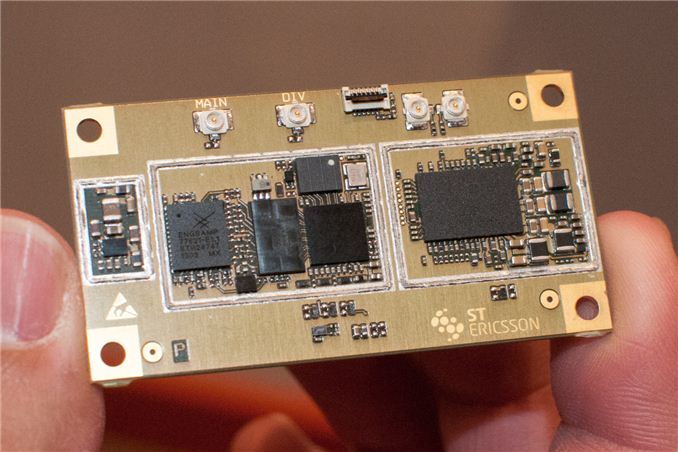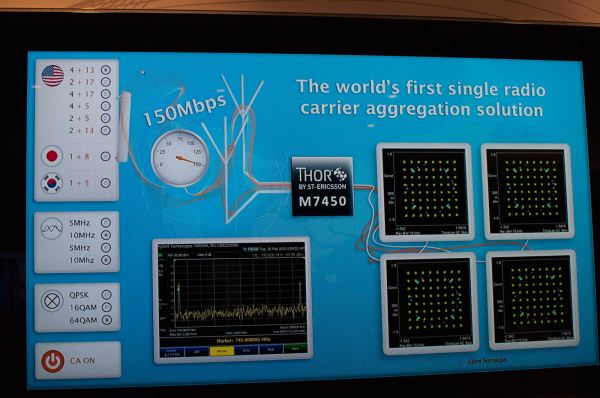A Look at ST-Ericsson's THOR M7450 Category 4 LTE Modem with Carrier Aggregation
by Brian Klug on February 26, 2013 4:39 AM EST- Posted in
- Smartphones
- LTE
- Mobile
- ST-Ericsson
- M7450

Earlier this morning we stopped by ST-Ericsson to talk about their SoCs and modem platforms, and took a look at their new Thor M7450 baseband which includes both support for 10 MHz + 10 MHz carrier aggregation to realize full category 3 and 4 speeds, and of course category 4 support. M7450 is built on a 28nm LP bulk process, though I'm told that there will be future parts also supporting FD-SOI similar to the new L8580. This is the same IP block integrated into ST-E's L8580 SoC, and includes support for both TDD and FDD LTE alongside WCDMA/HSPA+, TD-SCDMA, and GSM, all the 3GPP suite. ST-E believes its modem architecture in M7450 is very different from traditional designs, as it leans more towards being an SDR than most.
We had a chance to see M7450 demonstrating both UE Category 4 speeds and carrier aggregation on a number of different band combinations, interestingly enough 4 + 17 (AT&T), 4 + 13 (VZW), and 2 + 17 (AT&T) in addition to a few others. M7450 of course supports 5+10 and 5+5 aggregation as well.
Anand and I also got a chance to check out M7450 doing a VoLTE voice over IMS call running AMR-WB on the platform, which touts power consumption on a VoLTE call at levels equal to or less than a WCDMA call. There was a visualization showing the platform performance on the current VoLTE call versus WCDMA (for the same platform) which was at the same level or below basically the entire time. M7450 is currently sampling and expected to be in devices by the end of the year.

















15 Comments
View All Comments
evonitzer - Wednesday, February 27, 2013 - link
I was happy to read it and look up acronyms. They're all on wikipedia people! It's coverage of something new coming from MWC -- oh sorry, Mobile World Congress -- and might start turning up in devices. Listen to the podcast too. Brian continually talks about these topics on the show.EE Grad student in communications, but you don't do wireless? Well, I guess that's not crazy, but it seems you would have taken a class or two along the way.
TDD - Time Division Duplexing, multiplexing the uplink and downlink in time.
FDD - Frequency Division Duplexing. Same, but with frequency.
3GPP - 3rd Generation Partnership Project. The standards board for a lot of wireless tech.
VoLTE - Voice over LTE. Exactly what it sounds like. Currently voice goes over 3G or 2G, but VoLTE allows it to go through LTE too.
WCDMA/GSM - Wideband Code Division Multiple Access. We know this, right? AT&T, T-Mobile, and lots of others use it for signals.
TD-SCDMA - Time Division Synchronous Code Division Multiple Access - Never heard of it, but China uses it instead of WCDMA.
FD-SOI - Fully Depleted Silicon on Insulator - No idea, but it sounds great, right?
Ok, maybe it is a little out of control. Better than no coverage at all though!
lever_age - Wednesday, February 27, 2013 - link
I wasn't so clear earlier.My research is in wireless (which in our program doesn't require a single class dedicated to wireless channels and concepts, and definitely none on current wireless standards; digital communications / coding / information theory are the fundamentals anyhow), but I don't really keep up with current wireless industry standards and acronyms. The ones like TDD, FDD, and CDMA are engineer-speak, but some of the trade names and standards names are of course not. Then again, maybe I should keep up to date. Many recent M.S. graduates are at Qualcomm and so on, after all.
Now, you have more dedication than me for some of this alphabet soup.
ludwigbo - Wednesday, February 27, 2013 - link
what Francis answered I'm amazed that a mother can get paid $5511 in 4 weeks on the computer. have you seen this web page BAM70.combakedpatato - Wednesday, February 27, 2013 - link
If the baseband is SDR-lite(which is quite cool,SDR is really taking off), does that mean that the Skyworks amp there is amplifying signals in the 2/4/5/13/7 bands? That seems rather impressive as well.Also, TMOUS is doing AMR-WB over WCDMA. Does their implementation use IMS as well?
anat17 - Tuesday, March 5, 2013 - link
I was wondering if we use TDD instead of FDD, will we still get 150 Mbps on Cat.4 device?